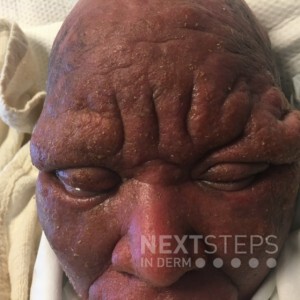
The correct answer is A. CD3+, CD4+, CD8-.
Folliculotropic mycosis fungoides is a distinct variant of mycosis fungoides characterized by the presence of folliculotropic infiltrates with preferential involvement of the head and neck region. Patients may present with grouped follicular papules, acneiform lesions, indurated plaques and sometimes tumors. Skin lesions are often associated with alopecia and sometimes mucinorrhea. Infiltrated plaques in the eyebrows and concurrent alopecia are common and highly characteristic. In most cases, the neoplastic T cells have a CD3+, CD4+, CD8- phenotype as in classic mycosis fungoides. Admixture with CD30-positive blast cells is common.
2 – In most cases of folliculotropic mycosis fungoides, the neoplastic T cells have a CD3+, CD4+, CD8- phenotype as in classic mycosis fungoides. Admixture with CD30-positive blast cells is common. 3 – In most cases of folliculotropic mycosis fungoides, the neoplastic T cells have a CD3+, CD4+, CD8- phenotype as in classic mycosis fungoides. Admixture with CD30-positive blast cells is common. 4 – In most cases of folliculotropic mycosis fungoides, the neoplastic T cells have a CD3+, CD4+, CD8- phenotype as in classic mycosis fungoides. Admixture with CD30-positive blast cells is common. 5 – In most cases of folliculotropic mycosis fungoides, the neoplastic T cells have a CD3+, CD4+, CD8- phenotype as in classic mycosis fungoides. Admixture with CD30-positive blast cells is common.
References:
A Swerdlow, E Campo, NL Harris, et al.: World Health Organization Classification of Tumours of Hematopoietic and Lymphoid Tissue. 2008 IARC Press Lyon
M Lutzner, R Edelson, P Schein, et al.: Cutaneous T-cell lymphomas: the Sezary syndrome, mycosis fungoides, and related disorders. Ann Intern Med. 83:534-552 1975 PMID 126656
Brought to you by our Brand Partner
![]()
